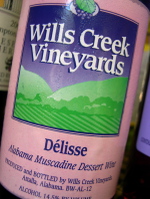 You’ve probably noticed that "50 States. 50 Wineries. 50 Weeks." has become merely 50 wineries from 50 states. That’s just because it’s been so much harder to gather samples than I anticipated. So, instead of doing one a week, I’ll taste them as I can get them.
You’ve probably noticed that "50 States. 50 Wineries. 50 Weeks." has become merely 50 wineries from 50 states. That’s just because it’s been so much harder to gather samples than I anticipated. So, instead of doing one a week, I’ll taste them as I can get them.
The goal is still to taste, and write about, wine from each of America’s 50 states.
This time around, we head to the deep south — Alabama — and Will Creek Vineyards.
I knew that this project would lead to tasting some interesting wines made from grapes outside of the Vitis vinifera realm, but the three Alabama wines I sampled were completely, off-the-charts unique…even if they tasted largely the same.
You see, these wines were made with the muscadine grape (Vitis rotundifolia), which is native to the southeastern United States. It’s
found in the wild from Delaware to the Gulf of Mexico and westward to
Missouri, Kansas, Oklahoma, and Texas. Actually, I should say muscadines because there are multiple varieties, including the most well known scuppernong.
Muscadine grapes have thick skin are huge compared to their northern cousins. In fact, some might be mistaken for small apples.
Not knowing much (okay anything) about these grapes or wines made from them, I wasn’t sure whether to chill them or not. Wills Creek sent me a white, a red and a dessert wine, so I did the usual — chilled the white and the dessert.
Anyway, I started with the white by tasting Wills Creek Winery’s Scupperdyme ($8), which isn’t really white at all. Made with the scuppernong, magnolia and carlos muscadine varieties, the color is more of a medium-deep brownish gold. Nena described it as topaz. It is extremely aromatic with aromas of flowers, wet pavement and plenty of the typical "foxy" character often found in native varieties. The palate wasn’t foxy at all, strangely, though it was a bit flowery. The dominant flavor was that of super ripe, just-turning-brown bananas. There is some sweetness here, but enough acidity for balance.
Next up was the red, Wills Creek Winery Ruby Red ($9), made with red muscadines. As the name would imply, the this wine is ruby red in the glass. I swirled, I sniffed — and this wine smelled nearly identical to the scupperdyme. There seems to be less floral aroma, but I probably couldn’t have told them apart if blindfolded. The flavor followed suit — very similar but with a little less acidity. But that could have been the fact that it wasn’t chilled. Chilling can make acidity more apparent.
Last in this lineup was Wills Creek Winery’s Delisse (N/A), which was my favorite of the three. The color of burnt sugar (think the top of a creme brulee), the aromas and flavors are similar to the other two wines, but there is some nice burnt sugar character that keeps the banana flavors in the background. The balance between sweetness and acidity is really impressive too.
For more information, visit www.muscadine.com for Wills Creek Winery.
